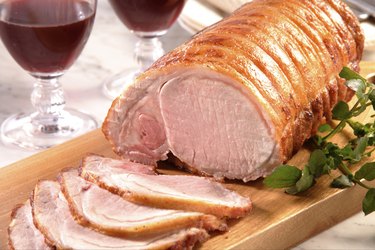
Cuts of pork carry a variety of names intended to describe which part of the animal the meat comes from as well as the type of cut and the size of the meat. Pork loin describes a cut of meat, while pork roast is all about the size. You can buy several different types of pork loin roasts, all of which provide protein, B vitamins and zinc.
Loin Vs. Roast
Video of the Day
Pork loin refers to a primal cut of meat, which is a large section that yields smaller retail cuts. The loin runs along the back of the pig from the legs to the shoulder and includes the upper portion of the pig's body. It's divided into three main parts: The blade comes from the section closest to the shoulder, sirloin cuts are near the rump and the center section falls between them. All three loin sections are used for roasts, because a pork roast is determined by the amount of meat being sold. A loin roast -- whether it's a blade, center or sirloin roast -- weighs 2 to 4 pounds.
Video of the Day
Similar Calories and Protein
A 3-ounce serving of blade roast, center loin roast and sirloin roast each provides 22 to 24 grams of protein, or 50 percent of women's and 41 percent of men's recommended dietary allowance. Center and sirloin roasts are lean choices. A 3-ounce serving of center roast contains 165 calories and 7 grams of fat, while a sirloin roast has 173 calories and 8 grams of fat. A blade roast provides 184 calories and 10 grams of fat, which is not quite lean because lean meat should have fewer than 9 grams of fat in 3 ounces, according to the University of Michigan Health System.
Rich Sources of B Vitamins
No matter which pork roast you prefer, you'll get a boost of B vitamins. A 3-ounce serving from each one contains more than 20 percent of the recommended daily intake of thiamine, riboflavin, niacin, vitamin B-6 and vitamin B-12. Sirloin roasts have a nutritional edge because they have more thiamine and vitamin B-6 than the other two cuts. Your body depends on all of the B vitamins to metabolize food into energy. Vitamin B-6 also supports your mood through its role converting tryptophan into the neurotransmitter serotonin. Vitamins B-6 and B-12 help synthesize red blood cells.
Zinc for Immune Support
Zinc affects your entire body, from synthesizing proteins and DNA to helping wounds heal and supporting your senses of taste and smell. If you don't consume enough zinc, your immune system weakens, the Office of Dietary Supplements reports. A pork roast from any section of the loin is a good source of zinc, but center and blade roasts provide 1.5 times more than a roast from the sirloin section. Based on consuming 2,000 calories daily, you'll get about 20 percent of the daily value from a 3-ounce serving of a blade or center roast and 15 percent from a sirloin roast.
- Pork Be Inspired: Buying, Handling and Storing Pork
- Cook's Thesaurus: Pork Loin Cuts
- Pork Be Inspired: Loin Roast
- Intsitute of Medicine: Dietary Reference Intakes - Macronutrients
- University of Michigan Health System: Healing Foods Pyramid - Lean Meat
- Harvard Medical School: Listing of Vitamins
- Office of Dietary Supplements: Zinc
- USDA National Nutrient Database: Pork, Fresh, Loin, Blade (Roasts), Bone-In, Separable Lean Only, Cooked, Roasted
- USDA National Nutrient Database: Pork, Fresh, Loin, Center Loin (Roasts), Bone-In, Separable Lean Only, Cooked, Roasted
- USDA National Nutrient Database: Pork, Fresh, Loin, Sirloin (Roasts), Bone-In, Separable Lean Only, Cooked, Roasted
- Pork Be Inspired: Pork Cooking Times and Temperatures
- U.S. Food and Drug Administration: Guidance for Industry - A Food Labeling Guide